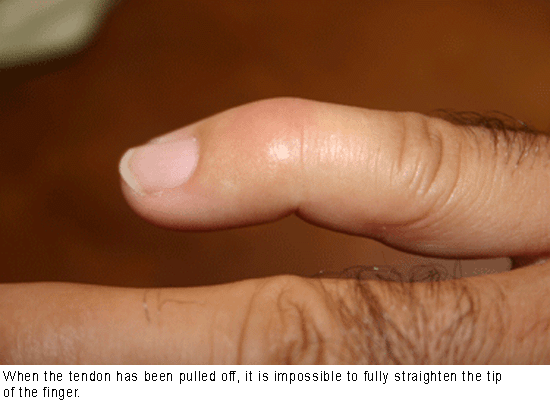Description
Mallet finger injuries occur when the tip of a finger or the thumb is forcefully bent. This condition is also known as baseball finger. It happens when a ball or other object strikes the tip of the digit. The force tears the thin tendon that allows you to straighten the finger. The force of the blow may even pull away a piece of bone along with the tendon.
Symptoms
A person with this injury has pain, swelling and bruising of the fingertip. The fingertip may droop noticeably. Occasionally, blood collects beneath the nail and the nail can even become detached from beneath the skin fold at the base of the nail.

Treatment Options
If you experience a mallet finger injury, immediately apply ice and elevate your hand above the level of your heart. Seek medical attention within the first week after this injury. It is very important to seek urgent attention if you have blood beneath the nail or if the nail is detached because you could also have a nail bed laceration or open (compound) fracture.
In most cases, the doctor will order X-rays to look for a major fracture or malalignment of the joint.
The majority of mallet finger injuries can be treated without surgery. The doctor may apply a splint to hold the fingertip straight (in extension) until it heals. Most of the time, you will have to wear the splint full-time for six weeks.
After six weeks, most patients gradually wean from the splint by wearing it less frequently over a three to four week period The finger usually regains acceptable function and appearance with this treatment plan; however, many patients may not regain full fingertip extension.
In children, mallet finger injuries may involve the cartilage that controls bone growth. A doctor must carefully evaluate and treat this type of injury, so the finger does not become stunted or deformed.
Treatment Options: Surgical
In certain cases, surgical repair may be considered. These cases include mallet finger injuries with:
- Large fracture fragments
- Joint malalignment
Surgical treatment in these cases often involves repair of the fracture using pins, pins and wire, or even small screws.
Surgery may also be considered if non-operative treatment fails. Repairing soft tissue mallet fingers is uncommon and usually reserved for patients with very severe deformities and functional problems. Surgical treatment can include tightening the stretched tendon tissue, using tendon grafts, or even fusing the joint straight. Consultation with an orthopaedic surgeon should be sought in these cases.
